Paper Doll
Organize To Reverse a Bad Day
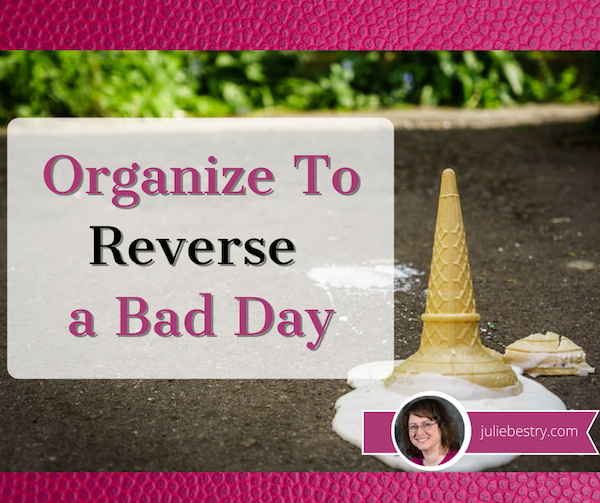
Summer Tears by Mark Seton (Creative Commons License)
In a perfect world, our time and task management wouldn’t depend upon our moods. Unfortunately, we don’t live in a perfect world.
In theory, our organizational systems should be designed so that we can accomplish our goals whether we’re feeling motivated or not. That’s the whole point of a system, to give us a framework when something external or internal prevents us from feeling our usual drive to achieve.
Last September, in Rhymes With Brain: Languishing, Flow, and Building a Better Routine, I wrote:
We also depend on activation energy. Because the hardest part of what we do is the getting started, we have to incentivize ourselves to get going. There are all sorts of ways we can trick ourselves (a little bit) with rewards, like pretty desk accessories or a coffee break, but the problem is that action precedes motivation. We’re not usually psyched to get going until we have already started!
Action precedes motivation. We're not usually psyched to get going until we have already started, whether it's a runner's high or Csikszentmihalyi's flow. Share on XWe may not feel like working out, but once we’re dressed in our best approximation of Venus and Serena, or the yogi of the moment, or whichever quarterback is getting all the endorsements, and have gotten ourselves warmed up, we’re well on our way.
When we lack our usual oomph, our knowledge of the benefits of staying organized may not be enough to keep us motivated to track our expenses, pay our bills on time, file our papers, and stick with our routines, but if we nudge ourselves with giving it just a little try (“just five minutes” or a Pomodoro of 25 minutes or whatever), we may find ourselves able to get into flow.
In other words, well begun is half done.
In that post on languishing, I talked about how to get past the (likely pandemic-induced) blahs and generate flow. We looked at several rhymes-with-brain solutions:
- Abstain from the distractions that steal your focus.
- Retrain your brain by shaking up the synapses and making different connections.
- Restrain yourself from frequenting the people who eating up your time and energy.
- Constrain your work areas and minimize the space they take up to keep from spending all your energy looking for your supplies and resources instead of using them to achieve your goals.
- Contain those items in the areas you’ve constrained (above).
- Maintain your successful routines.
- Attain (and explain) knowledge to keep your brain active.
- Gain momentum and jump-start your enthusiasm.
If you haven’t read that post, skedaddle over to it first, as conquering languishing might be just what you need.
BEYOND LANGUISHING
The problem with productivity is that sometimes, we’ll be going along just fine and hit a brick wall. If languishing is the “blah,” a really bad day is the “waaaaaaaaah.”
Judith Viorst captured it best in the title Alexander and the Terrible, Horrible, No Good, Very Bad Day. Whether you remember it from childhood, babysitting days, or from parenthood, you know what she means. There are days that can go wrong and completely wreck our moods and take our whole day off course.
Organize To Pay Your Bills On Time
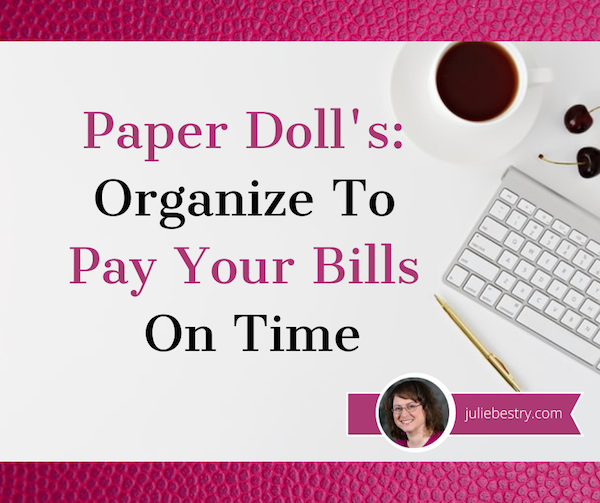
Photo by Leone Venter on Unsplash
After I wrote Ask Paper Doll: Should I Organize My Space and Time with Color? last week, I got to thinking about how color relates to finance, at least in terms of expressions.
Even though black usually signifies something dire, if you’re “in the black,” it means that you’ve got a net positive income, while finances that are “in the red” are considered bleak, signifying debt greater than revenue.
When you’re “in the pink” you’re in good health, financially or otherwise. And, although it would seem to make more sense that being “in the green” would mean you were flush with money, English lacks that expression. And I’ve learned that in Italian, “Sono al verde,” which literally translates as “I am at the green” means “I’m broke.” Language is funny.
You know what’s not funny? Late payments. Fines for late payments. Increased interest rates because of late payments. Lower FICO scores because of a history of late payments!
During consultations with new organizing clients, people often express frustration over difficulty paying their bills on time. Generally, it’s not that they lack the funds, but that their bill-paying systems get out of whack and fail to fit into their already overstuffed, overburdened schedules. Today, we’re going to look at strategies to get bills paid on time.

BEYOND THE BUDGET: KNOW THE WHO, WHAT, WHEN, WHERE, AND WHY
You might expect that I’d bring up the topic of a budget. Certainly, knowing all of your financial obligations is important to a smoothly-run financial life. As Charles Dickens said,
Annual income twenty pounds, annual expenditure nineteen six, result happiness. Annual income twenty pounds, annual expenditure twenty pound ought and six, result misery.
Annual income twenty pounds, annual expenditure nineteen six, result happiness. Annual income twenty pounds, annual expenditure twenty pound ought and six, result misery. ~ Charles Dickens Share on XIn order to pay your bills on time, it’s essential to know when they are due, and (if applicable) how that relates to when your income will arrive.
Make a chart of all of your creditors and bills. It’s best to do this on a spreadsheet, like Excel or Google Sheets so you can update the chart over time.
- Note when bills are due. Usually, you have three kinds of bills:
- Bills that are due on or around the same date every month (like rent/mortgage, health insurance, utility/cable/internet bills, credit card bills, etc.)
- Bills that are due on a regular cycle but not every month. They may arrive quarterly, like water bills, auto, renter’s, or homeowner’s insurance premiums, or tuition bills, or annually, like professional dues, memberships, or auto registration renewals.
- Bills that a have no regular cycle. These may be one-off bills, like occasional department store credit card purchases or service providers who bill at their convenience, sometimes after you’ve long forgotten about the expense.
- List the amounts or ranges of your regular bills.
- Some of your bills will have the same dollar amount every month, like health insurance or your cell phone bill, because they are regulated by a contract. (These are the ones that for which it is easiest to set up automated payments.)
- Other bills will vary by month due to different usage or consumption, like electric bills or credit card statements.
- List the amounts or ranges of your regular bills.
- Learn and list the penalty of paying late! — My office landline (yes, I said land line!) payment is due on the 28th of the month, but there’s a grace period until the 8th of the following month, at which point the extra fee is about $3. No biggie. However, the average late fee for U.S. credit cards is $36, and that doesn’t take into account that late payments can trigger higher interest rates. If your credit card balance includes a 0% balance transfer, you could lose that rate if you make even one late payment. Oh, and late payments can also wreck your FICO score.

Photo credit: Simon Cunningham under Creative Commons CC By 4.0 Deed
- Make a column for each month of the year so you can mark when you’ve made a payment. This way, you’ll regularly see your progress and recognize when a payment hasn’t been made.
Yes, this sounds like homework, and you may be thinking that if you had the time to do homework in the first place, you’d be able to pay your bills on time.
However, having a sense of how many bills you have, in what amounts, due when, and with what penalty for paying late, can make all the difference in getting your finances in order.
PICK YOUR BILL-PAYING STYLE
No one bill-paying system is necessarily better than the others, but picking a method that works for you will help you stay committed to the process.
Pay Bills the Day They “Arrive”
This simple strategy requires the least amount of advanced planning and you’ll never have to worry that procrastination will lead to late fees.
If you get your bills by mail:
Bring in the mail every day, open the envelopes, toss out extraneous junk and “shiny” advertising material, and pay your bills immediately. Done! (Now log that you’ve paid it on the chart.) People rarely have more than a few bills each day, and if you get in the habit of doing this diligently, it’ll take only a few minutes out of your daily schedule.
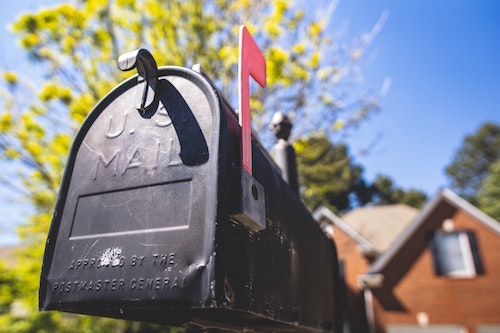
Photo by Abstrakt Xxcellence Studios from Pexels
If you have opted out of paper bills:
Open your email every day, log in (to either your bank’s bill-pay site/app, or the account’s website), pay your bill, and log that you’ve done it. Bing, bang, boom!
Paying bills the day they arrive saves time (because it’s easy to complete quickly), eliminates anxiety regarding whether you may forget to pay, and helps you stick to your budget. If you pay for all of the things for which you have already obligated yourself, you’re less likely to spend on wants before needs.
This is the easiest system, but it’s also the least-often used.
Some people avoid this option because they lack the funds to pay each bill on the day it arrives. If our two biggest bills (for example, mortgage and insurance) arrived on the same day, it might wipe out (or even exceed) our checking account balances. So, there may be a practical reason to skip this method.
But there are far more common reasons why people don’t pay their bills as they arrive.
For some, there are psychological or philosophical obstacles to using this strategy. They may think, for example:
“I’m not going to pay this bill until right before it’s due. They don’t deserve my money one minute earlier than necessary!” [Insert your own “harrumph” as necessary.]
We see this most often when someone wants to avoid paying a credit card bill before the due date. People are fine paying for their electricity or health insurance, because they see that they’re getting the benefit already, so payment feels “fair.” But with credit cards, it’s common to forget that payment was actually due upon purchase; the cards simply shifted the time frame. People forget that a credit card bill is actually an IOU, the debt having been incurred in the past.
If you struggle with this philosophy, there’s still a way to pay bills as they arrive to prevent late payments.
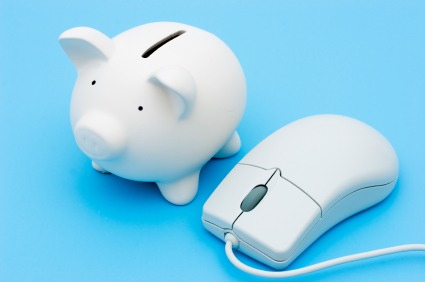
If you pay bills online, log in now but schedule each payment for a day or two before it’s due. (Waiting until the day it’s due can cause holiday/weekend kerfuffles.)
If you pay by check, write out the checks, but put them in your tickler file (see below) or clip them to the calendar page of the date when you’re comfortable mailing them so only that final step remains.
“I don’t like paying my bills in dribs and drabs. I want to pay them all at once.”
This is similar to not wanting to hang up one shirt, or not wanting to file each piece of paper as you finish with it, or not wanting to wash each dish (or put it in the dishwasher) when done eating. It makes sense…until you find yourself with a backlog.
Sure, there’s something to be said for flow, doing a large project once and pushing through it to give your the satisfaction of completing a major task. However, the more we let our clothes pile up on the exercise machine, the more we let our filing pile up in the office, and the more we let the dishes pile up in the sink, the more of a behemoth the task seems, and the more likely we are to procrastinate altogether.
The downside of procrastinating on those tasks are wrinkled clothes, messy offices, and dried-on kitchen yuckiness. The downside of procrastinating on bill-paying? Late fees, increased interest rates, and lowered FICO scores.
Tickle Yourself Organized
If you don’t do something immediately, you have to do it later. Sadly, that’s just one of the laws of physics, that we can’t go back in time. (That said, if you find yourself with a time machine or TARDIS, please let Paper Doll know. I have some experiments I’d like to try.)
Later requires a system, and a system requires both geographic and behavioral changes from what you’ve been doing thus far.
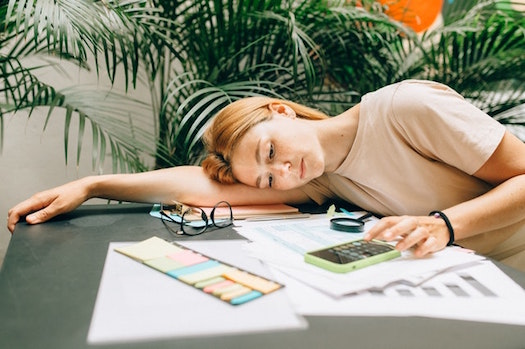
Photo by Nataliya Vaitkevich from Pexels
Geographically, you need a bill-paying center with the following tools:
- Tickler file, or at least a bill-paying folder
- Letter opener (to avoid paper cuts and add pizzazz to opening envelopes)
- Calculator or calculator app
- Pencil and scrap paper (if you have an untenable relationship with calculators)
- Envelopes
- Stamps
- Return address labels
- Non-washable gel-ink pens (to deter identity theft and fraud) to write out checks OR a printer if you prefer computer-generated checks
This assumes you’re getting your bills in the mail and paying them by check. If you’re paying them digitally, you can skip the envelopes, stamps, and return address labels.
The behavioral process is similar to the pay-upon-arrival system. Show up for mail call. (Seriously, I want you to open your mail every day. But if you absolutely won’t, at least put all of your mail in one spot, near your bill-paying area, and commit to opening ALL the mail at least once per a week.)
Open the envelopes, toss out the glossy advertising inserts, and if you pay online, toss the envelopes, too. Even if you’re not going to pay right away, process each bill immediately to keep it from ending up on top of the microwave or mixed in with your third grader’s math homework.
Eyeball each statement to review the charges, note any unexplained fees, and check for new policies and/or errors. (The sooner you catch a billing error or a policy change you don’t like, the easier it is to address.)
Circle or highlight the payment due date. Then figure out how far ahead you want to pay the bill. Take a glance at the calendar to make sure there are no weekends or federal holidays that might cause delivery obstacles.
If the due date is consistently inconvenient (because of when you get paid, or when lots of other bills are due), ask the vendor to change the date to a more convenient one. Many credit cards let you change your due date from inside the account profile.
Once you’ve opened each bill and figured out when you want to pay it, arrange them in chronological order by due date with the one due soonest on top. You can stop here and just tuck the stack in a folder, but longtime readers know that I encourage you to use a tickler file.
I used to tell folks to put the bills in slots at least 7 days in advance of when they’re due, but with the change in postal service delivery speeds, I encourage mailing at least ten days in advance or paying online. Or, make it even easier on yourself and only pay bills one day per week (like Tuesdays), and then just pick a pay date that’s two Tuesdays (or whichever) prior to the due date.
Ask Paper Doll: Should I Organize My Space and Time with Color?
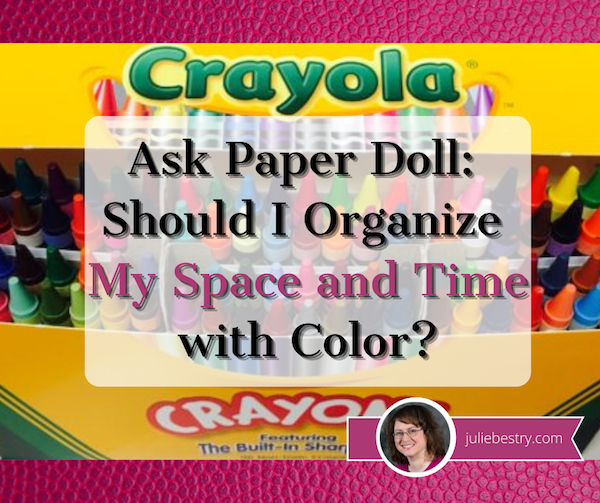
This is part of a recurring series of Ask Paper Doll posts where you can get your burning organizing questions answered by Paper Doll, a 20-year veteran professional organizer and amateur goofball.
Dear Paper Doll:
It’s only January and I’m already at a loss for motivation. I’ve been thinking about using color to organize my office and maybe my calendar, but the more I look at my options, the more overwhelmed I get. How can I organize by color and not constantly be tinkering with my systems and remembering what color goes where?
Signed,
Feeling grey with a case of the blues
Grey sky, grey streets, grey mood? Even if we weren’t in the second winter of a pandemic, January is a tough month to feel sparkly. We’re still nine weeks away from Daylight Saving Time, so our late afternoons are dark and gloomy. Plus, after the ongoing glow of holidays from late November through New Year’s Day, of course you’re feeling a loss of spark.
And yes, color is a great way to pump up the mood. If color weren’t so vital, Pantone wouldn’t be known worldwide for coming up with its color of the year. By the way, Paper Doll is a huge fan of this year’s color, Very Peri.

But organizing by color and organizing with color can be very different things.
ORGANIZING BY COLOR
Some people are enthusiastic about using color to organize everything in their homes, offices, and lives. Maybe they have a signature color that serves as a personal brand; others believe in color-coding and sorting everything by hue. Paper Doll isn’t necessarily keen on that. Using color to decide where something goes and with which it is grouped depends on the situation.
Organizing clothing or shoes by color? Sure. Imagine you have all of your long-sleeved shirts hanging in the closet, in roughly ROY-G-BIV color order, or group all your black pumps together, then the blue, then the red, and so-on within your collection of heels.
This will make it easy to recognize you’ve tipped the scale toward full-on goth when you’ve got 17 black turtlenecks, or may be mistaken for Dorothy if most of your shoes are ruby red. Sorting and ordering your clothes and shoes by color makes sense, but probably as a secondary sorting characteristic within clothing/shoe types.

Organizing your calendar by color? Absolutely! Whether you grab a selection of pretty markers to fill in your paper planner (medical appointments in red, billing or tax dates in green, social events in purple) or use the settings in Outlook, Gmail, or any other digital calendar, you can color-code to your heart’s delight.
And the best thing? If you select the wrong color, you don’t need white-out or an eraser to fix it. One little click, and you’re back in business!
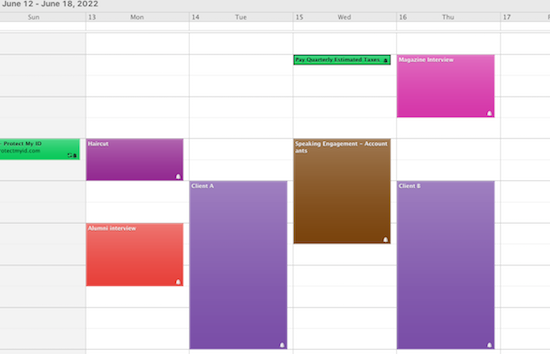
Organizing files by color? Mayyyyyyyybe. I hate to sound coy, but the effectiveness of a system based on color-coding files depends on the level of commitment of the user.
In the abstract, it can be great to organize your files (either tabbed folders or hanging folders) by color. Figure out what your overarching categories are, and assign colors to those categories, whether in your reference or action files. For example:
- Red folders — Urgent tasks or information you always need to get your hands on in a hurry
- Green folders — Financial information related to taxes, payable accounts, and investments
- Blue folders — Planning, like for vacations or work projects
- Yellow folders — Client information or class materials
- Purple folders — Creative tasks
and so on. Color (as we’ll see below) stirs emotions, creates enthusiasm and motivation, and triggers action. What could be better?
The problem isn’t with the system, per se, but with the users. If you let yourself run out of yellow folders just as you sign on a new client, what will you do? Are you likely to order new folders in that color scheme right away? If so, you’re set. If not, you may let a pile of papers related to that client languish in the corner of your desk, risking them getting mislaid or lost.
Plus, keeping many different boxes of colored tabbed folders can be expensive and get out of balance quickly. You may use three times as many purple folders as red ones and your red box may sit year after year, mostly untouched.
If you want to embrace color, there are a few other options beyond a full-on color-coding assault. You could:
- Pick your favorite color, and use those tabbed folders exclusively.
- Start with just two or three of your most used categories and pick colors to define each of those. You’ll still be using color as a sort of trigger or label, as above, but you won’t be going “whole hog,” at least not at the beginning.
- Use plain manilla tabbed folders, but pick a beloved color for hanging folders. (Because hanging folders hold tabbed folders, and can generally accommodate three-in-one, we don’t run out of them as quickly.) Traditional olive/army green hanging folders aren’t likely to cheer anyone up, and using a fun hanging folder uniformly through your filing system will brighten your mood without requiring you to keep up with a complex system.

(These purple Smead hanging folders are bright and bold, and are available in most Big Box stores and at Amazon for $17.89 for a box of 25.)
Organizing your spices by color? How experienced a chef are you that you could catch yourself before you added a visibly similar (but wrong) spice to a recipe? Ground nutmeg, cloves, and cinnamon look alike; but would you want to risk grabbing the wrong one and making iced nutmeg rolls or clove-raisin coffee cake?
Are you willing to mistake similarly-red cayenne pepper for paprika? Perhaps it’s better to group spices by the categories of usage (baking tasks vs. preparing meat/vegetables, etc.). SpiceAdvice has a nice Quick Reference Spice Chart sorted by usage categories.
Organizing your books by color? Oh, gracious. This question has stirred quite a bit of controversy over the last few years. I mean, there’s this person:
I feel like coordinating books by color is one of those things you either love or are wrong about. pic.twitter.com/U6GfIZLgnQ
— Jennifer Wright (@JenAshleyWright) July 15, 2020
I’d take umbrage, but I’m too busy worried about how cold her legs must be.
And then there’s Clea Shearer and Joanna Teplin from the Netflix program Get Organized with the Home Edit. They’re known for their passion for color-coding, and they did that with a few bookshelves on their show. But they were children’s books, and let’s face it, the way tiny humans pull books off shelves, it’s not like alphabetized books are going to stay that way. (Their background, at the above link, shows a full set of bookshelves for grownups arranged by color. I’m looking around for my fainting couch.)
Magazines have been rife with headlines in favor of organizing books by color. For example, Jezebel ran with a piece called Sorry, Color-Coded Bookshelves Look Good, while Slate stood up for the design-oriented folks with Arranging Your Books By Color Is Not a Moral Failure.
Of course, in this highly competitive media market, every online magazine’s job is to stir controversy and curry clicks. Thus, I suspect these headlines recognize that those of us who read may care more about the content of our books than using them as decor and are trying to drive some righteous indignation clicks to their sites.
But Paper Doll stands firmly in the NOPE category on organizing books by hue. The color of a book’s cover is about marketing; it was almost certainly chosen by a marketing team based on the designs in fashion for that genre during that season. The color may not even have been approved by the author or seem to make sense. I mean, even early versions of Alice Walker’s The Color Purple didn’t have a purple book cover or spine!
 I’m a practical person. I believe that function should always come before form. A gorgeous outfit that doesn’t cover all your fleshy bits and gives you frostbite? Nuh-uh. A bookshelf that requires you to remember the color of the cover vs. letting you just walk over to peruse the category (fiction? organizing? recipes?) or authors? I can’t countenance that.
I’m a practical person. I believe that function should always come before form. A gorgeous outfit that doesn’t cover all your fleshy bits and gives you frostbite? Nuh-uh. A bookshelf that requires you to remember the color of the cover vs. letting you just walk over to peruse the category (fiction? organizing? recipes?) or authors? I can’t countenance that.
I’m not saying you can’t do it; I’m saying I can’t advise it.
And that’s because, as a professional organizer, my role is to help you live a more organized and productive life. Sure, I’ll leave your space looking better than it did before, but my reason for being in your space is to leave it working better than it did before.
ORGANIZING WITH COLOR
So, what’s the difference?
Organizing by color requires creating a system. With clothes or shoes, it might just be ROY-G-BIV and keeping things in order. When you put away your clothes, as you approach with a freshly-laundered shirts on hangers, you’ll be able to put away each item in the general color order. It’s your closet, so you don’t have to be too persnickety unless Vogue is coming to do a photo layout of your walk-in, in which case, good for you!
With file folders, as described above, organizing by color requires a stricter system. In effect, you’re deciding, up front, what all of your categories will be and assigning colors to those categories. You have to be willing to stop, each time you create a folder, to consider what category the contents of the folder belong to, and select that color every time. If you’re comfortable with that, then you have my blessing. I just don’t want to see you get stressed out.
You also have to be relatively sure that you’ll “feel” this association going forward (unless you’re just having fun and don’t care whether there’s a cognitive connection between your colors and your categories); if you soon realize that you hate the color orange but have assigned orange to your accounts payable, you might stop filing your paid bills or (eek!) avoid paying them altogether.
Organizing by color can be great, and I’m absolutely in favorite of it, as long as you, as an individual, feel comfortable sticking to a system. If not, that’s OK. There are still magnificent ways to organize your life with color, without adhering to strict or narrow categories.
Organizing with color lets you pick functional objects that add a pop of color but don’t require a lot of mental or physical effort to maintain.
It’s more thematic than systematic.
It’s sort of how we talked about about goals and resolutions vs. picking a word of the year. (If you haven’t read Review & Renew for 2022: Resolutions, Goals, and Words of the Year, this is a great time to help you get back on that motivation kick!) Goals — and the habits we embrace to achieve them — are like the systems for organizing by color; a word, mantra, or theme of the year, rather, provides a sense of focus, and color can do that for you.
Pantone does it with the color of the year; you can brand yourself, or your year, with color that’s meaningful to you! Think, “2022 in Royal Blue!” (Good luck rhyming a year with periwinkle or burnt sienna, though.)
Let’s get a sense of what color psychology tells us. Our friends at Quill created a nifty explanation to help explain some of the meanings of color in “Color Code Your Way to an Organized Workspace with Office Products.”
Do you have to use the specific colors that are associated with specific feelings? Of course not. I don’t particularly find the color yellow to be “associated with hope, happiness, and positivity.” I don’t even buy the original yellow Post-it® Notes because yellow just doesn’t do it for me. (I’m so into pinks and purples, as you might have guessed.)
But do experiment and take advantage of the aspects of the psychology of color to make your space your own.
A FEW FUN WAYS TO INTRODUCE COLOR INTO YOUR LIFE THIS SEASON
Our friends at Time Timer have come up with some gorgeous, new colorful timers.
First, they’ve released their original 8″ timers in Learning Center Classroom Sets (of 3) in two different color schemes. But you don’t need to be using them in a classroom to brighten up your office or workspace. There’s a primary color set:
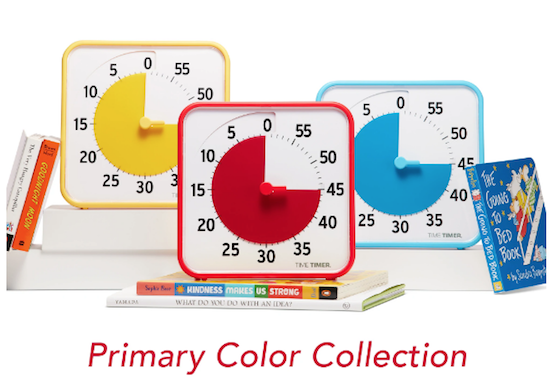
and a secondary color set:
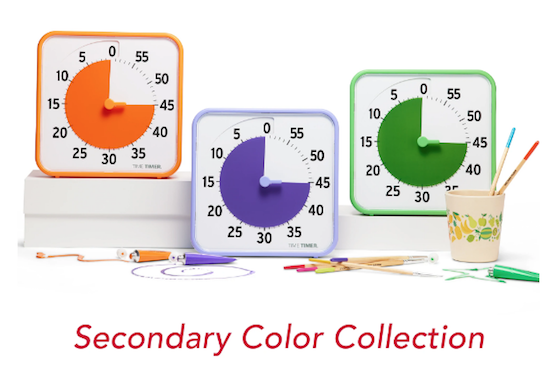
These sets are priced (for pre-order) at $104/set. Again, these are designed for learning activities, but there’s no reason why you couldn’t have one timer in your office, one in your kitchen, and one in your workout area.
Each set comes with three Original 8″ visual timers (for up to a 60-minute duration) with magnetic backs and fold-up feet, three dry erase cards for labeling the current activity (great for helping you focus during a 25-minute pomodoro task), and one free download of the Time Timer Desktop App.
They’re also selling a Time Timer MOD® – Special Edition Tie-Dye version (for pre-order) for $36.95. I’m a big fan of the little MODs, and this 3 1/2″ square MOD provides a tiny pop of color while helping you visualize time passing, and keep you motivated to accomplish your tasks.
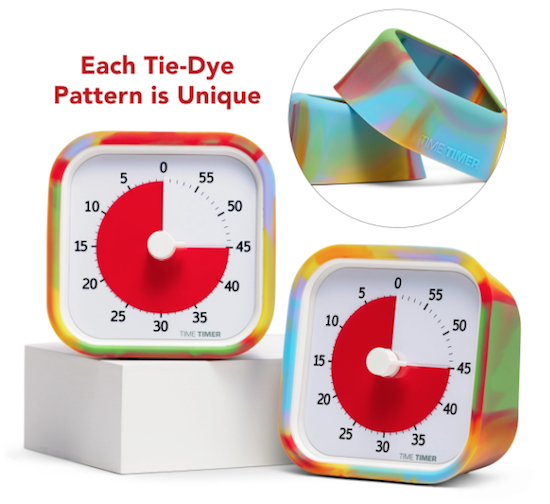
For a burst of color for office supplies, consider Poppin desk, wall, and office accessories:
You can buy their products directly from the Poppin website, or at Staples, Quill, and The Container Store. Be sure to check out Poppin’s Work From Home section for more fun, motivating bursts of color.
Do you like to wrap yourself up in color or just use it for accents?
Are you comfortable with intricate color-coding systems, or do you just want to surround yourself with your favorite hues?
And what’s your favorite color?
Meet me in the comments and tell all!
Paper Doll’s 22 Ways To Celebrate GO Month 2022

Welcome to GO Month 2022! This is the annual celebration of our attempts to eliminate chaos and help our world make a little more sense. For members of the National Association of Productivity and Organizing Professionals (NAPO) this is our 4th of July, New Year’s Eve, and pretty much every other holiday all rolled into one. We invite you to celebrate with us!
Chances are good that when you read last week’s post (you did read last week’s post, right?), Review & Renew for 2022: Resolutions, Goals, and Words of the Year, you strengthened your resolve (if not actual resolutions) to get organized, be more productive, or do something to further your dreams. Today, we’re going to look at 22 tips to start 2022 in ways to help you get closer to your dreams.
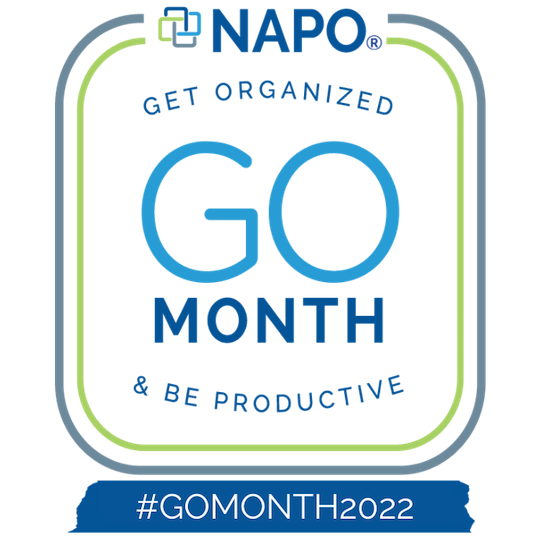
CLOSE OUT THE HOLIDAY SEASON
1) Purge your holiday cards. While you’re taking down the tree and putting away decorations, collect all of the greeting cards you’ve received in one pile and do a reality check. So many people save all of their cards, boxed up, and never look at them again. Not you, not again.
Read the cards one last time. If Hallmark did all the labor and there’s only a short message or a signature, give yourself permission to toss and recycle the cards. If there’s no deeply personal message that makes you laugh or cry, let it go. After all, you don’t transcribe your holiday phone conversations and keep them forever.
2) Let go of other people’s greeting card pictures. And those cards that are just collages of the families of people you worked with 20 years ago? You’re allowed to let them go, too. You don’t have to be the curator of the museum of other people’s family photos.
3) Update your contacts. As long as you’re tossing holiday cards, check the return addresses on the envelopes and update the information in your own personal database, whether that’s in the contacts app on your phone or in an ancient Snoopy address book.
PICK AND PREP YOUR PLANNER
4) Buy your new planner. Now. And then make a note to buy your 2023 calendar by Thanksgiving next year.
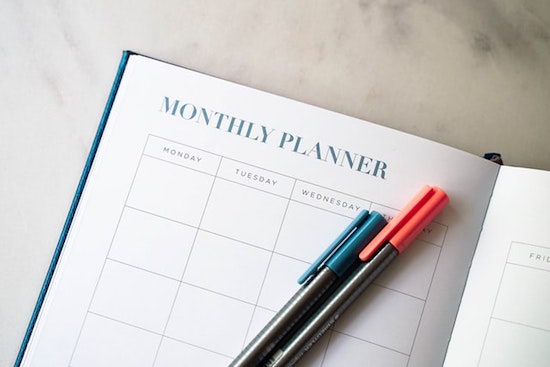
Are you still scribbling appointments on those extra, orphan, three-lines-per-month “planning” sections at the back of your 2021 planner? If you don’t have a planner that will make sure you honor all of your commitments, now is the time to do it! Consider these concepts:
- Choose a planner that lets you see a month at a glance. Daily and weekly views don’t offer enough long-range details to let you plan your life over time.
- Select a planner that has enough space for you to write. Paper Doll has sprawling, messy penmanship, and I know a pocket-sized paper planner would cramp my style, literally and figuratively. Note that even when you’re looking at a monthly view, digital calendars tend to hide most of the details.
- Use only one planner for your business and personal appointments. If you keep one calendar for your doctors’ appointments and schedule for your kids, and another for work, you’ll never know if your child’s recital conflicts with a major client presentation, or if you’ve scheduled yourself to attend a work conference the week your kids have school vacations. I’ll admit this is where digital calendars like Google’s have an advantage, as you can, with the click of a box, layer or remove different calendar views.)
As a professional organizer, I think the key to organizing your life is being able to visualize your time, whether that’s the hours in the day or the projects in the year. As Paper Doll, I think the best way to do that is with a paper planner.
But if you’re a digital devotée, you do you! However, a digital calendar makes it a little harder to flip back and forth between last January and this one, last February and this one, etc., to make sure everything is as it ought to be. (Yes, in a perfect world, you’d put people’s birthdays in as recurring dates and meetings that used to be every 2nd Tuesday would continue thusly, but with digital planners, there’s a lot of extra fiddling to do to make sure things don’t fall through the cracks.)
5) Update your calendar by filling in all the details.

Go through last year’s planner and copy over everything that recurs on the same dates (like birthdays and anniversaries).
Then add in the things that happened last year and are already scheduled to happen again, but not on the same dates (like conferences, work retreats, mammograms, medical appointments, etc.).
6) Use last year’s calendar to help prompt you to make a list of everything you need to schedule or add to your long-range tasks, like setting an appointment with your CPA to discuss tax issues.
7) Commit to a planner system. Commitment to your calendar is like having Jeeves as your butler. If you pay Jeeves poorly (and try to use a 12-page stapled calendar from a local funeral home) or don’t feed him (and forget to enter your appointments as you schedule them), such neglect will yield one insolent, neglectful butler (or a calendar of conflicts, illegible notes, and missing appointments). Not every butler is as loyal as P.G. Wodehouse’s Jeeves or Downton Abbey’s Mr. Carson.

Nurture your commitment to your planning system…every day. If there’s so much going on in your life that you forget to mark appointments in the first place or fail check your planner until it’s too late, upgrade your accountability:
- Set an alarm on your phone to ring at around 5 p.m. daily to remind you to check your calendar and tickler file for the next day and the coming week.
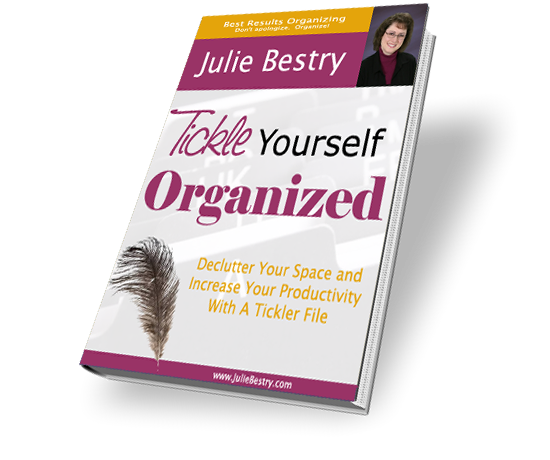
- If you have an assistant (especially if you are both working remotely) schedule time each day to talk and review newly-added appointments and obligations.
- Have a family meeting on the weekend to make sure every appointment and school pick-up is covered.
- Schedule your next appointments before leaving anyplace you visit intermittently (doctor, dentist, massage therapist, hair or nail salon, etc.) — but only if you have your calendar with you. Otherwise, ask them to call you. Never agree to any date without your planner nearby.
MAKE 2022 THE YEAR YOU YOU ARE A VIP WITH YOUR VIPs
8) Get your vital documents in order.
Longtime readers know how I feel about making sure you have all of your VIPs (very important papers) in line. From tornados and hurricanes to the recent wild fires in Colorado to everything the world has experienced with the COVID pandemic, it’s never too soon to get your papers (and affairs) in order. Check in with these posts for step-by-step guidance to making sure you’re covered.
How to Replace and Organize 7 Essential Government Documents
How to Create, Organize, and Safeguard 5 Essential Legal and Estate Documents
The Professor and Mary Ann: 8 Other Essential Documents You Need To Create
Protect and Organize Your COVID Vaccination Card
9) Clean out your wallet and make an inventory.
It’s been a long time since I wrote my creaky 2008 series on what you should and shouldn’t keep in your wallet, but the advice in What’s In Your Wallet? (Part 3): A Little Insurance Policy boils down to the fact that you need to keep an inventory of the licenses, insurance cards, and debit/credit cards you have in there and all the information contained on them.
Back then, I advised wallet protection services, photocopying or scanning the fronts and backs of your wallet contents, or logging a digital database in a spreadsheet. Nowadays? Unless you have a scanner at hand, just pull everything out of your wallet, make two columns of cards on the table, and take a photo with your smartphone. Then flip each card over in the same position, and photograph the back. Finally, password-protect the document on your phone or in your cloud back-up, secure in the knowledge that your info is safe.
MAKE SENSE OF YOUR MONEY, HONEY!
10) Create a Tax Prep folder.
If you do nothing else this month, setting aside a safe place to collect tax information will at least prevent essential financial paperwork from building up or getting lost. You’ll save time (in CPA or TurboTax hours) and money (in CPA dollar-hours and tax deductions).
Starting near the end of January and continuing through mid-February, your mailbox, email inbox, and digital financial accounts will be filled with lots of weirdly named and numbered forms. (For some idea of their significance, review Paper Doll’s Tax-Smart Organizing Tips: 2021, though this will be updated once the IRS releases more information for the new tax year.) Just pop them in a manila folder in your financial files or in a dedicated holder like the Smead All-in-One Income Tax Organizer.
Review & Renew for 2022: Resolutions, Goals, and Words of the Year

Snuggled in this week, tucked away between two major holidays, it’s tempting to rush to end the year with some sense of completion on those unfinished tasks. As much as we’d like to be mindfully in the present, we’re zipping along, trying to impose control in an era when there’s very little control to be had.
So today, I propose you take a breather. Bask in the quiet glow before we rush headlong into the future. Take time to do a little review of the past year so you can feel renewed, and if not in control, at least in awareness, for 2022.
TAKE A BACKWARD GLANCE
The best way to grow is to built on one’s successes. Grab a cup of cocoa (or whatever makes you feel alert but cozy) and settle in someplace comfy.
Pull out your calendar, whether it’s digital or paper bound, and start taking note of your successes, achievements, and delights. Personally, I think it’s best to keep a running list on paper (I mean, I am Paper Doll, after all), but if you prefer a spreadsheet, Word doc, or a note in Evernote, by all means, go with what feels comfy.
Look Beyond the Obvious
You can definitely list big accolades, awards, or milestones. Sure, mark down when you hit your revenue goal or finished that marathon. But look at those subtle successes, too.
What did you stick with, even when it was hard? Success isn’t always marked by what you attain, but how you persevere!
What did you try, even though it was out of your comfort zone? Succeeding at what you’re good at is worthy of pride, but stepping up to do something scary but potentially rewarding? That’s magical. (For more on that, check out my Sara Skillen’s Organizing and Big Scary Goals: Working With Discomfort and Doubt To Create Real Life Order.)
What surprisingly good things occurred that you had never even thought to imagine in the first place?
What dreams came true? Where did you decide to make new dreams when the old ones proved untenable (due to life or world circumstances)?
Janet Barclay’s excellent Set Your Compass to Reach Your Goals for the New Year introduced me to the free, downloadable YearCompass, an international marvel. Even if you get nothing else from today’s post, I encourage you to download this fillable, printable PDF and explore the questions. Examine your past year and get guidance for going forward.
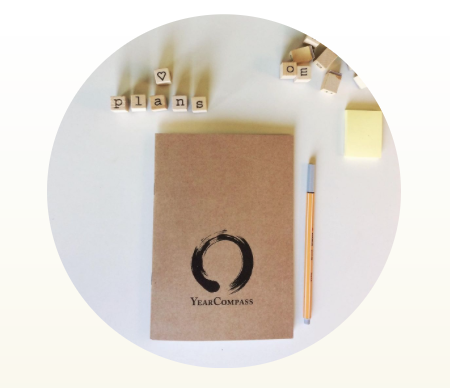
I’m working my way through the digital version now, and it’s providing more insight than I’ve received from any prior annual review.
If you prefer an even deeper dive (and are willing to use up lots of Post-its®), try doing a life audit, examining the past, present, and future of your life. Or go shallower, cut to the chase, and stick to Apartment Therapy’s 6 Smart Questions to Ask Yourself at the End of the Year.
Not everyone can weave a tapestry of the past year out of the blocks of a calendar, so this is just a start. If you journal, flip through the pages to look for highlights, and recognize that bad days are actually achievements. You got through them and made it through the other side. (You’re here to read this, right?)
Surf through your social media posts. You may be surprised by what you find on LinkedIn or Facebook (or, yes, TikTok or Instagram). Look for a sense of all the big and little ways you did your thing, or helped others do their things! In particular, look at places where you were tagged for shoutouts and gratitude. There are lots of people always touting having gratitude, but sometimes it’s nice to notice and remember when you did something worthy of someone else’s gratitude or kudos.
Ah, kudos! Speaking of which, definitely check your Success Folder! Don’t have one? Create one! Actually, create two.
Have a digital success folder where you put emails that praise or thank you, or otherwise give you warm fuzzies. While you may get fewer and fewer things by mail, have a paper folder for collecting such tangible high-fives. On days where you are down on yourself, feel under-appreciated, or are disappointed, pulling out something that reminds you that “good stuff happens” and that you’re part of that chain of events is going to lift your spirits.
Engage With Your Village
Raising a child isn’t the only thing that takes a village; count on others to help lift your spirits and give you insight.
Talk to your people. We’re not always good at keeping formal records of our successes, but our friends and loved ones automatically catalog the snazzy things about us. Once, a friend was entering the workforce for the first time in decades, and was bemoaning the fact that she had no marketable skills. But because I’d known her (just about) forever, I was able to recite everything from events she’d run as a volunteer coordinator to the time she caught a PTA high muckety-muck embezzling! She sure-as-heck had marketable skills, but couldn’t immediately see them in herself, let alone recognize her own magnificence.
Want to increase the magic? Recognize your own successes, but also pay attention to your friends’ and colleagues’ achievements. Share their blog posts on your social platforms instead of just clicking “like.” Promote their professional highlights. And send them emails and even write to them the old-fashioned way so they have something to put in their own Success Folders!
MOVING FORWARD: TRIED AND TRUE FOR ’22
Armed with insight into what we achieved (and what we wish we had tried) in the prior year, we can approach the new year. First, we’ll look at the classic approaches, but we’ll also examine some exciting new ways to support our dreams as we move forward into 2022, even if it’s about to be “COVID’s junior year.”
Resolve to Evolve
In general, New Year’s resolutions come in two flavors, either positive or negative.
With positive resolutions, we say we’re going to proactively do something. Maybe we’ll do Couch-to-5K or learn a language. For negative resolutions, we plan to eliminate some aspect of our lives that we know is dragging us down, so we vow to go on a diet or stop hate-watching The Bachelorette.
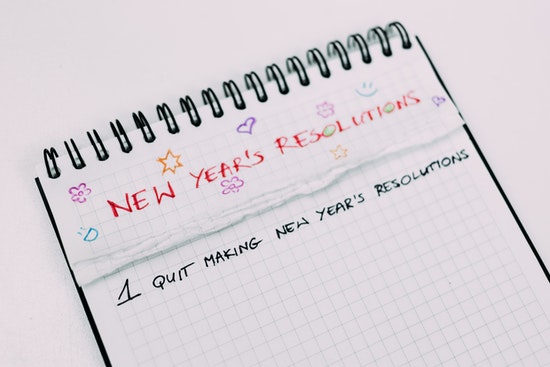
Photo by freestocks.org from Pexels
Resolutions date back many, many centuries. Four thousand years ago, the Babylonians promised the gods they would return borrowed objects and repay outstanding debts. (If only the Babylonians had had professional organizers to help them declutter and locate the borrowed stuff and couch cushion money.)
The Romans promised their two-faced god Janus, who looked simultaneously backward and to the future, that they’d be good in the year to come. And for several hundred years, Christian watch night services have included traditions of reflecting on the prior year and making resolutions for the one to come.
In the United States, resolution-making continues to increase; up to 40% of the population makes a New Year’s resolution. On the up-side, these resolutions help us start the new year in a motivated, positive way – right when the weather, the amount of sunlight, our bank balances, and our moods are at an annual low-ebb. December 31st is when we feel our age and recognize the passing of another year of unfulfilled potential; resolutions rev our engines.
On the down-side, the vast majority of people abandon their resolutions before February. Resolutions fizzle for three reasons:
- our real lives get in the way (year after year after year)
- our resolutions may be things we’re supposed to do, but aren’t passionate about
- we haven’t identified working strategies for achieving our resolutions
So, if you are going to make a resolution, make sure you’re picking things that excite and challenge you, but also figure out how to eliminate the past obstacles and ease your path.
For inspiration on developing new or different resolutions, consider some of the following:
Good Housekeeping‘s 60 Achievable New Year’s Resolutions for Healthier and Happier Living 2022 has less all-encompassing, more bit-sized resolutions, like “Prioritize age-appropriate health screenings,” “eat more vegetables,” and “listen to novels while you work out.
The Pioneer Woman has 40 New Year’s Resolution Ideas to Start 2022 Right, with some fun, sociable ideas like “give more compliments,” “send more cards,” and “make time to spend with family and friends.”
And Antimaximalist’s whopping 67 New Year’s Resolutions for 2022 prioritizes hopeful notions like, “Don’t settle for less than you deserve” and “Be less afraid of making mistakes.”
You can resolve to do things that are fun, too. Gretchen Rubin made a list of 21 things she wanted to do in 2021:
Here’s my 21 for 2021 list. I got a fair number of things crossed off my list. Now I’m writing my 22 for 2022 list—and deciding what items to carry over from 2021. pic.twitter.com/KmdMXUBAPu
— Gretchen Rubin (@gretchenrubin) December 21, 2021
and has a PDF to help you track your 22 in ’22.
Embrace Good Goals and Happy Habits
So, how can you supercharge your resolutions? Maybe stop thinking of them as big, sparkly things you resolve to do (with the unspoken societal expectation that it’ll all fall through), and consider the less flashy younger siblings of resolutions, ye old goals and habits.
Think of goals as providing the big-picture framework, the big city markers on the map; habits are the turn-by-turn directions to get you where you want to go.
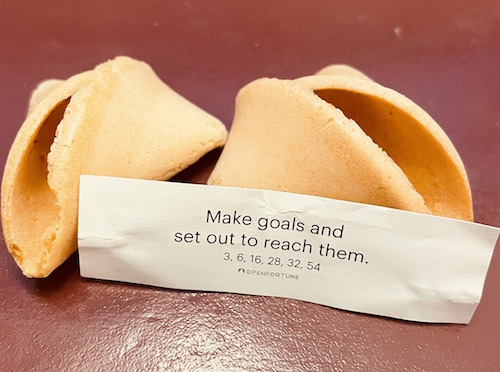
SMART goals are popular because they identify where resolutions and plans often fail.
- Specific (What are you going to do? Use action verbs! Where and when are you going to put these efforts into effect? With whose help or partnership will you get there?)
- Measurable (What metrics will you use to show you’ve done what you said you’d do? How many miles per day? How many lessons per week? How many blocks of time for achieving specific tasks?)
- Achievable (Is this a practical goal? Is it realistic?)
- Relevant (Does this goal make sense for your life, family, or business?)
- Time-based (When will you start? When will you perform the action? When will you repeat it? When will you finish? Remember, “Someday” is not a day on the calendar!)
And Paper Doll readers know that I prefer SMARTY goals, where that Y reflects the idea that these are goals that are meaningful to YOU, not your mother-in-law, boss, or favorite Instagram influencer.
I prefer SMARTY goals, where that Y reflects the idea that these are goals that are meaningful to YOU, not your mother-in-law, boss, or favorite Instagram influencer. Share on XWhether you want to lose weight, pay off debt, find a significant other, or grow your business, the goal can’t just be a vague “what I want” without any guideposts. Make sure your goals spell out what you’re going to do, how you’re going to do it, and how you’re going to measure your success.
So, if your goals set the rules and create the game plan, habits are how you get to the finish line.
If your goal is to get to work on time every day, but you often find yourself searching the house for your keys, wallet, phone, and charger, then you’ll want to develop a habit of assigning a “home” and always putting those items in the home upon returning to your house, before you even take off your shoes. If your goal is to be prepared at tax time, then your habits involve doing weekly record-keeping and filing, and not waiting until April 12th to get started.
Habits are your settled or repeated tendencies. Sure, bad habits become second nature, making them hard to break, but good habits are hard to break, too! So, if you can get in the habit of repeating positive, life-affirming tasks, you stand a much better chance of achieving your goals.
I recommend a few superior books for understanding how habits work, and how you can put them to use in your life. Both are becoming modern classics.


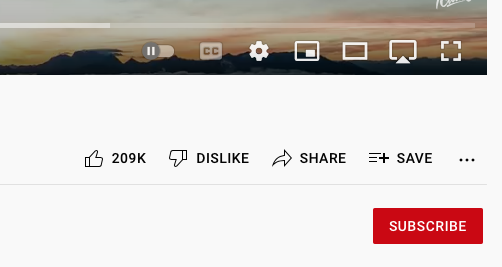


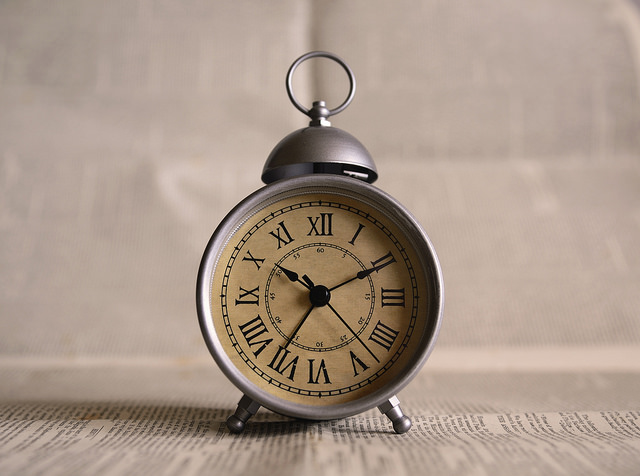



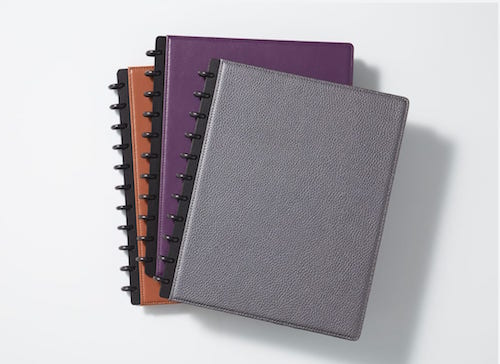

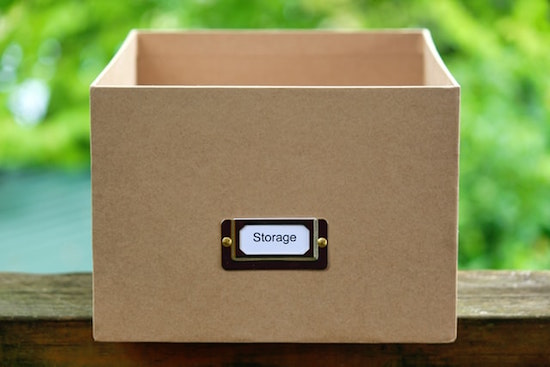





Follow Me